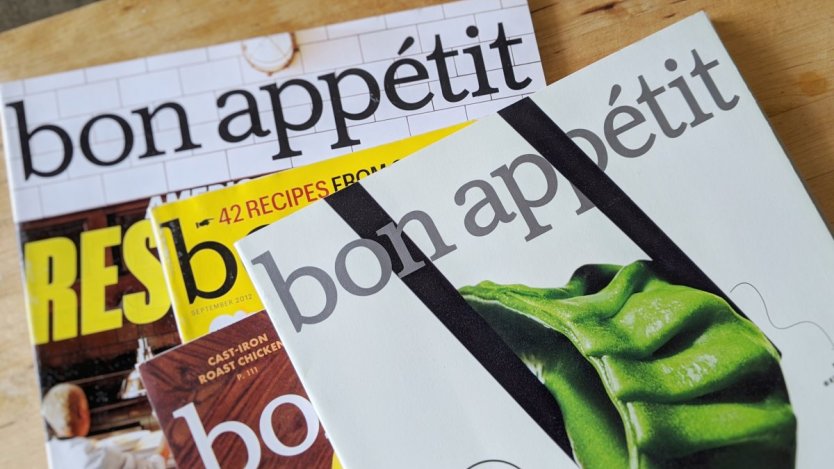A tidal wave of change has hit the food media industry, one which is welcomed by many.
Yesterday, we watched Bon Appétit, a pillar of the international food media industry, fall from grace after being called out for extensive systemic racism. Adam Rapoport, the magazine’s well known editor-in-chief, resigned at the end of the day after allegations of unfair treatment of people of colour on staff surfaced online.
The former editor first came under siege yesterday morning when a social media post from 2013 by Rapoport’s wife Simone Shubuck resurfaced, in which the duo dressed as Puerto Ricans for a Halloween party in 2004. The culturally-insensitive photo was immediately labelled “brown face” on social media and condemned for its reinforcement of negative stereotypes.
However, the outrage only worsened for the publication throughout the day when several employees alleged that internal practices of people of colour on staff were unfair and tainted by systemic racism. Sohla El-Waylly joined Bon Appétit as an assistant editor almost one year ago, but has quickly become a fan favourite in Bon Appétit’s YouTube videos.
El-Waylly was one of the first BA staff members to speak out about the situation. She posted a series of Instagram stories sharing her experience with systemic racism, stating: “I’ve been pushed in front of video as a display of diversity. In reality, currently only white editors are paid for their video appearances. None of the people of color have been compensated. I demand the (sic) not only the resignation of @rapoport but also to see BIPOC given fair titles, fair salaries, and compensation for video appearances.”
from sohla’s Instagram stories
— defund the fucking police (@emdwu) June 8, 2020
bon appetit’s lack of diversity is obvious from the video content that spurred its massive following, but to find out that only white editors are paid for video appearances? i am disgusted pic.twitter.com/PVqyrZ22RU
Another employee, Alex Lau, Bon Appétit’s former photographer also tweeted, “Yes, I left BA for multiple reasons, but one of the main reasons was that white leadership refused to make changes that my BIPOC coworkers and I constantly pushed for.”
Lau continued on to state that his requests to shoot cuisine that would be reflective of more cultures were shot down.
i've been quiet. i've been quiet about this for so long, because i always thought that i could actually change the organization from within. but i was wrong, and quite frankly i am so glad that the internet is going after BA and holding them accountable.
— Alex Lau (@iamnotalexlau) June 8, 2020
Within a few hours, Bon Appétit staffers, from familiar on-camera talent to writers and video producers, continued to post about the culture that perpetuated the white washing of content and inequalities faced by their BIPOC colleagues.
Molly Baz, senior editor and one of Bon Appetit’s most famous YouTube personalities, even posted that she would “not appear in any videos on Bon Appétit” until BIPOC colleagues received equal pay and fair compensation. Others who are frequently featured on Bon Appetit’s channel followed suit to voice their support.
Molly Baz from @bonappetit calling for a strike from videos until BIPOC coworkers receive equal pay and video compensation pic.twitter.com/lS95hDlmyH
— Gabe Rosenberg (@GabrielJR) June 8, 2020
By Monday evening, Adam Rapoport had announced that he was stepping down, stating: “From an extremely ill-conceived Halloween costume 16 years ago to my blind spots as an editor, I’ve not championed an inclusive vision.” So far, Conde Nast (Bon Appétit’s parent company which also operates magazines such as Vogue magazine) has made a statement on Twitter about their zero-tolerance policy on discrimination and harassment, but has yet to address the Bon Appetit allegations directly.
So, what can the food media and hospitality industry learn from the Bon Appétit controversy?
As with other industries whose people practices have come under close examination recently, this is an opportunity for the Canadian food industry and food media to turn the microscope on ourselves.
Firstly, representation matters. Bon Appétit is not unique in tailoring their content to suit a North American audience. Like Bon Appétit, many other publications, media outlets, and even restaurant awards default to recipes and restaurants that suit a mainstream, westernized following. However, as access to diverse voices grows, so does awareness and curiosity for those stories.
As food media and business owners, we are accountable for sharing stories that are representative of the diversity of our country. We can start by examining our own default setting by asking ourselves some questions.
Where are we sourcing our stories from? Are we showcasing a diverse range of stories? How do we find the right people to tell these stories?
Collectively, we can work at cultivating diverse voices in our food community. This may include thoughtful posting of internship opportunities to capture a diverse pool of applicants, and re-examining the competencies and “fit” we seek to avoid focusing on attributes that belong to a particular demographic of the population.
Restaurant awards and accolades often exclude non-mainstream businesses by evaluating service standards based on North American norms, minimizing the opportunity for businesses owned by people of colour to be considered. Similarly, broadening the diversity of the judging panel and their exposure to a variety of cuisine will help to ensure representation of different cultures.
Secondly, the familiar excuse, “But that’s how we’ve always done things” is not good enough. Adam Rapoport’s behaviour was unacceptable, but I don’t believe that he was the core issue. An organization’s practices and culture is shaped by the actions of its leaders and team members, including the inaction of a team. Bon Appétit’s practices were accepted by and tolerated for years. Adam Rapoport, who came to Bon Appétit from GQ, another publication in the Conde Nast family, was likely a product of the Conde Nast culture.
This is a reminder that we all have a stake in shaping the environment that dictates how others around us are treated. When we don’t show up or challenge status quo practices that are unfair, we are contributing to that issue.
In the case of Bon Appétit, inequitable assignments and compensation practices seem to be long standing accepted norms. It’s commendable to see so many employees at Bon Appétit speak out on social media in support of their BIPOC colleagues; however, the show of support comes after years of accepting the system in this state.
It can be intimidating to challenge enduring norms.
Start by inviting different perspectives to provide feedback on your current processes to uncover blindspots and look at ways you can improve. Present viable options to address the folks who say, “We’ve always done it this way,” and be prepared to explain the risks that come with not making a change.
Finally, be clear on what you stand for, both as consumers and as business owners. As readers, we have a responsibility to choose who we support. Where we choose to spend our money is a direct way to convey our recognition of a business for their values. This becomes even more important in a time when we’re facing economic challenges. For Bon Appétit, the story was told publicly by its employees, who seem to be united in articulating what they collectively stand for. However, it was met without direct response from the leadership at Bon Appétit and its parent company Conde Nast.
Businesses can go much further by re-establishing their vision for diversity.













